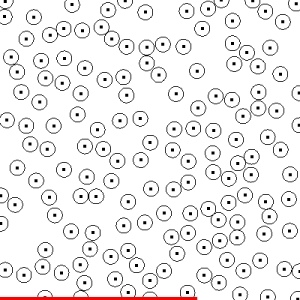Accurate Multi-dimensional
Poisson-disc Sampling
Manuel N. Gamito
Lightwork Design Ltd
Steve C. Maddock
The University of
Sheffield
We present an accurate and efficient method to generate samples based
on
a Poisson-disk distribution. This type of distribution, because of its
blue
noise spectral properties, is useful for image sampling. It is also
useful for
multi-dimensional Monte Carlo integration and as part of a procedural
object
placement function. Our method extends trivially from 2D to 3D or
to any higher dimensional space. We demonstrate results for up to four
dimensions, which are likely to be the most useful for Computer Graphics
applications. The method is accurate because it generates distributions
with the same statistical properties of those generated with the brute
force
dart-throwing algorithm, the archetype against which all other
Poisson-disk
sampling methods are compared. The method is efficient because it
employs
a spatial subdivision data structure that signals the regions of space
where
the insertion of new samples is allowed. The method has O(N logN) time
and space complexity relative to the total number of samples. The method
generates maximal distributions in which no further samples can be
inserted
at the completion of the algorithm. The method is only limited in the
number
of samples it can generate and the number of dimensions over which it
can work by the available physical memory.
This paper was published in the ACM
Transactions on Graphics journal. The final version of the paper is
available from the ACM Digital
Library. The paper was also selected for presentation at the SIGGRAPH 2010 conference. A
draft version of the paper is available below:
PDF
format (4.9 M) (poisson.pdf)
The source code for the prototype described in the paper is made
available below.The application is written in C++ and requires the Boost library and also an
implementation of the OpenGL Glut library.
The application has been successfully compiled in Windows with
Microsoft Visual Studio 2008 and under the Cygwin Unix emulator. The application
should also compile in Linux without problems. If possible, the
application should be compiled on a 64bit operating system with more
than 4Gb of memory, given that the adaptive subdivision tree, used as
part of the Poisson-disc sampling, can require considerable amounts of
memory.
Gzipped Tar
file (16 K) (poisson.tar.gz)
Some Animations from the Paper
Here are a couple of animations using the sampling method presented
in the paper. They show several aspects of the sampling process in two
and three dimensions. Note that the examples shown have been slowed down
overall in order to visualise the sampling process better. Had these
examples been presented in real time, they would have terminated too
quickly for anything but the final result to be perceived. The red
progress bar at the bottom of each animation indicates the percentage of
space inside the unit square or cube that has been eliminated from the
sampling process.
 |
An animation that shows the generation
of a 2D distribution with samples surrounded by discs of radius r/2. No
discs intersect, illustrating that the distribution is correct.
Quicktime
MOV format (1.1M) (halfdiscs.mov) |
 |
An animation that shows the same 2D
distribution with samples surrounded by gray filled discs of radius r.
No white regions are visible at the end of the clip, illustrating that
the distribution is complete.
Quicktime
MOV format (360K) (fulldiscs.mov) |
 |
An animation that shows again the same
2D distribution and represents the leaf nodes in the subdivision tree
as purple squares of several sizes. The allowable regions for insertion
of new samples are contained inside the collection of leaf nodes.
Quicktime
MOV format (913K) (treenodes.mov) |
 |
An animation that shows the generation
of a 3D distribution with samples represented as spheres of radius r/2.
There is no intersection between spheres.
Quicktime MOV
format (4.0M) (cube.mov) |
 |
An animation that is similar to the
previous one with an additional clipping plane, showing that no spheres
are intersecting.
Quicktime
MOV format (3.6M) (cubeclipped.mov) |
back to main page




